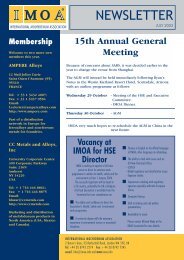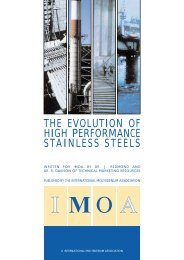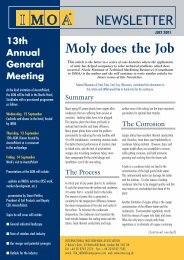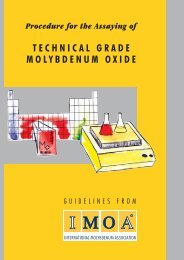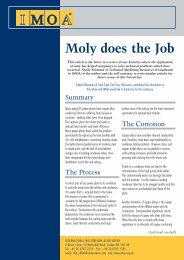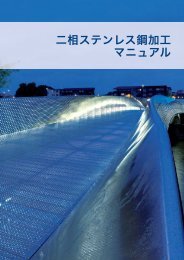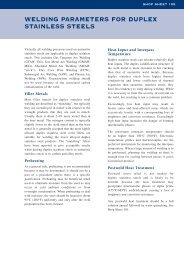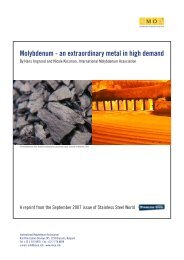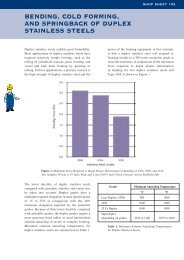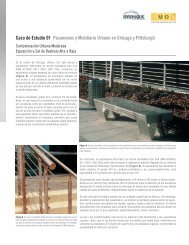Weighing and sampling of Molybdenite Concentrates - IMOA
Weighing and sampling of Molybdenite Concentrates - IMOA
Weighing and sampling of Molybdenite Concentrates - IMOA
Create successful ePaper yourself
Turn your PDF publications into a flip-book with our unique Google optimized e-Paper software.
Procedure for the <strong>Weighing</strong><br />
<strong>and</strong> Sampling <strong>of</strong><br />
MOLYBDENITE<br />
CONCENTRATES<br />
© 1997<br />
Published by the International Molybdenum Association (<strong>IMOA</strong>)<br />
Unit 7 Hackford Walk, 119 - 123 Hackford Road, London SW9 0QT, Engl<strong>and</strong><br />
Tel: + 44 171 582 2777 Fax: + 44 171 582 0556<br />
E-mail: ITIA_<strong>IMOA</strong>@compuserve.com<br />
Guidelines from the<br />
INTERNATIONAL MOLYBDENUM<br />
ASSOCIATION
INTRODUCTION<br />
I<br />
M O<br />
A<br />
Other current titles in this series are:<br />
• Procedure for the <strong>Weighing</strong> <strong>and</strong> Sampling <strong>of</strong><br />
Technical Grade Molybdenum Oxide<br />
•<br />
Procedure for the <strong>Weighing</strong> <strong>and</strong> Sampling<br />
<strong>of</strong> Ferromolybdenum<br />
Future titles:<br />
•<br />
This Guideline on good practice in<br />
relation to the <strong>Weighing</strong> <strong>and</strong> Sampling<br />
<strong>of</strong> <strong>Molybdenite</strong> <strong>Concentrates</strong> is one <strong>of</strong> a<br />
six part series on <strong>Weighing</strong>, Sampling<br />
<strong>and</strong> Assaying which has been drawn up<br />
<strong>and</strong> published by the International<br />
Molybdenum Association for the<br />
benefit <strong>of</strong> its members <strong>and</strong> the industry<br />
at large.<br />
The aim <strong>of</strong> the <strong>IMOA</strong> Sampling <strong>and</strong><br />
Assaying Sub-committee was to prepare<br />
worldwide industry guidelines to<br />
improve consistency <strong>and</strong> quality in<br />
<strong>Weighing</strong>, Sampling <strong>and</strong> Assaying procedures<br />
for <strong>Molybdenite</strong> <strong>Concentrates</strong>,<br />
Technical Grade Molybdenum Oxide<br />
<strong>and</strong> Ferromolybdenum.<br />
Procedures for Assaying <strong>Molybdenite</strong> <strong>Concentrates</strong><br />
Procedures for Assaying Technical Grade Molybdenum Oxide<br />
Procedures for Assaying Ferromolybdenum<br />
The International Molybdenum Association (<strong>IMOA</strong>) was<br />
established in 1989 <strong>and</strong> has become the focal point <strong>of</strong><br />
promotional, statistical <strong>and</strong> technical activities for the<br />
worldwide molybdenum industry. Membership is broad<br />
based <strong>and</strong> includes producers, consumers, converters,<br />
traders <strong>and</strong> assayers. <strong>IMOA</strong>'s secretariat is based in London.<br />
<strong>IMOA</strong>'s main activities currently include:<br />
promoting molybdenum as a material with superior<br />
•<br />
properties <strong>and</strong> performance in a wide variety <strong>of</strong><br />
metallurgical, chemical <strong>and</strong> other product applications;<br />
monitoring molybdenum in relation to health, safety<br />
•<br />
<strong>and</strong> environmental issues; with the increasing amount<br />
<strong>of</strong> legislation in many countries relating to the use <strong>and</strong><br />
disposal <strong>of</strong> metals <strong>and</strong> metal bearing materials, <strong>IMOA</strong><br />
provides a centralised service including research studies<br />
on those issues that may affect the molybdenum industry;<br />
collecting the industry's most comprehensive<br />
•<br />
historical statistics on world supply <strong>and</strong> dem<strong>and</strong> <strong>of</strong><br />
molybdenum products which are distributed to all<br />
<strong>IMOA</strong> members on a regular basis;<br />
organising meetings <strong>and</strong> promotional conferences<br />
•<br />
beneficial to the molybdenum industry; <strong>and</strong><br />
preparing worldwide industry guidelines to improve<br />
•<br />
consistency <strong>and</strong> quality in <strong>sampling</strong> <strong>and</strong> assaying<br />
procedures for molybdenum compounds.<br />
“ These guidelines relating to weighing <strong>and</strong> <strong>sampling</strong> procedures for <strong>Molybdenite</strong> <strong>Concentrates</strong> are provided for<br />
reference purposes only. They are designed to promote the st<strong>and</strong>ardisation <strong>of</strong> weighing <strong>and</strong> <strong>sampling</strong><br />
methodology, with a view to improving quality <strong>and</strong> reliability for molybdenum Producers, Consumers, Converters,<br />
Assayers <strong>and</strong> others in the industry. Use <strong>of</strong> the guidelines is purely voluntary on the part <strong>of</strong> the user, <strong>and</strong><br />
participation in <strong>IMOA</strong> does not create an obligation on anyone to adhere to these guidelines. <strong>IMOA</strong> makes no<br />
warranty <strong>of</strong> any kind, whether <strong>of</strong> merchantability, fitness for a particular use or purpose, or otherwise in any<br />
<strong>Molybdenite</strong> <strong>Concentrates</strong> that has been weighed <strong>and</strong> / or sampled using these guidelines ”.<br />
2<br />
15
5. DISTRIBUTION/COST ALLOCATION<br />
• Documents to be distributed to: ..............................................................................................................<br />
......................................................................................................................................................................<br />
......................................................................................................................................................................<br />
......................................................................................................................................................................<br />
......................................................................................................................................................................<br />
• Samples to be distributed to: ....................................................................................................................<br />
......................................................................................................................................................................<br />
......................................................................................................................................................................<br />
......................................................................................................................................................................<br />
......................................................................................................................................................................<br />
• Reserve samples stored at:........................................................................................................................<br />
......................................................................................................................................................................<br />
......................................................................................................................................................................<br />
......................................................................................................................................................................<br />
......................................................................................................................................................................<br />
Address for invoice: ......................................................................................................................................<br />
......................................................................................................................................................................<br />
......................................................................................................................................................................<br />
......................................................................................................................................................................<br />
......................................................................................................................................................................<br />
N O T E S<br />
1.<br />
2.<br />
Procedure for the <strong>Weighing</strong> <strong>and</strong> Sampling <strong>of</strong><br />
MOLYBDENITE CONCENTRATES<br />
SCOPE AND FIELD OF APPLICATION<br />
This best practice guideline specifies a method for weighing <strong>and</strong> <strong>sampling</strong> <strong>Molybdenite</strong><br />
<strong>Concentrates</strong> for their chemical quality.<br />
The procedure shall be applied to each individual Lot. Lot size is defined between the<br />
contract parties involved, <strong>and</strong> shall be clearly stated in the <strong>Weighing</strong> <strong>and</strong> Sampling reports.<br />
These reports shall also specify the control procedure used, e.g. the “<strong>IMOA</strong> Procedure for the<br />
<strong>Weighing</strong> <strong>and</strong> Sampling <strong>of</strong> <strong>Molybdenite</strong> <strong>Concentrates</strong>.”.<br />
If other procedures or st<strong>and</strong>ards are used, they are to be specified in the W/S report.<br />
Auger<br />
DEFINITION OF TERMS<br />
Means a coarse spiral with a diameter <strong>and</strong> flight spacing <strong>of</strong> at least 10 mm, <strong>and</strong> an<br />
operational length at least the depth <strong>of</strong> the material in the container. It is capable <strong>of</strong> being<br />
rotated mechanically through the full depth <strong>of</strong> material <strong>and</strong> <strong>of</strong> withdrawing a complete plug<br />
<strong>of</strong> material from the bulk.<br />
Calibration<br />
Means the process <strong>of</strong> comparing <strong>and</strong> adjusting measurement systems or procedures<br />
against Certified Weights, or against Certified Reference Materials. This process is carried out<br />
strictly in accordance with International St<strong>and</strong>ards. The International St<strong>and</strong>ard used in the<br />
Calibration process is to be specified in the Calibration report.<br />
Certificate <strong>of</strong> <strong>Weighing</strong> <strong>and</strong>/or Sampling<br />
Means a report <strong>of</strong> the activities, observations <strong>and</strong> readings executed during the control<br />
procedure. This report can be issued by the producer <strong>of</strong> the product, by the receiver <strong>of</strong> the<br />
product or by an organisation independent <strong>of</strong> the two parties. In the latter case, the Certificate<br />
becomes an independent Certificate, the minimum content <strong>of</strong> which is defined in the<br />
Guidelines for Instructions to the Supervisor for Inspection, <strong>Weighing</strong>, Sampling <strong>and</strong><br />
Reporting.<br />
Every Certificate must be duly signed by an authorised person.<br />
Clean Certificate<br />
Means a Certificate issued without qualification when both <strong>of</strong> the following conditions have<br />
been met:<br />
1. The equipment available for carrying out the procedure<br />
conforms to the <strong>IMOA</strong> guidelines.<br />
2. The procedure followed conforms to the <strong>IMOA</strong> guidelines.<br />
14<br />
3
4<br />
Claused Certificate<br />
Means a Certificate issued containing a statement that one or both <strong>of</strong> the following<br />
conditions prevail:<br />
1. The equipment available for carrying out the procedure does not conform to the<br />
<strong>IMOA</strong> guidelines.<br />
2. The procedure followed does not conform to the <strong>IMOA</strong> guidelines.<br />
Consignment<br />
Means Molibdenite <strong>Concentrates</strong> delivered within a specific period agreed between the<br />
contract parties concerned. A Consignment may consist <strong>of</strong> one or more Lots, or part <strong>of</strong> a Lot.<br />
Increment<br />
Means the quantity <strong>of</strong> <strong>Molybdenite</strong> Concentrate collected in a single operation <strong>of</strong> the<br />
<strong>sampling</strong> device.<br />
Lot<br />
Means the smallest unit to be weighed <strong>and</strong> for which a Sample <strong>and</strong> an assay have to be<br />
produced, as agreed between the contract parties.<br />
Report <strong>of</strong> Findings<br />
Means a report to be issued when it is considered that facilities <strong>and</strong>/or conditions are<br />
proven to be unsatisfactory to perform weighing <strong>and</strong>/or <strong>sampling</strong> in accordance with the<br />
<strong>IMOA</strong> guidelines, specifying the reasons.<br />
Sample<br />
• Gross Sample<br />
Means the quantity <strong>of</strong> <strong>Molybdenite</strong> Concentrate in its received state, which results from<br />
the combination <strong>of</strong> all Increments <strong>of</strong> a Lot.<br />
• Preparation <strong>of</strong> Gross Sample<br />
Means the process <strong>of</strong> division, milling, mixing, sieving, etc, <strong>of</strong> the Gross Sample in<br />
the prescribed manner, resulting in the Fine Sample.<br />
• Fine Sample<br />
Means the prepared Sample after the prescribed division, milling, mixing <strong>and</strong> sieving<br />
steps, to be divided into Assay Samples.<br />
• Assay Sample<br />
Means the Sample drawn from the Fine Sample for the purpose <strong>of</strong> determining the<br />
required chemical quality parameter(s) <strong>of</strong> the sampled Lot, <strong>and</strong> which can be<br />
described as “Volatile Free at 105°C - may contain heavier oil fractions”.<br />
Top Size (for determining <strong>sampling</strong> equipment, division, milling, sieving in relation<br />
to <strong>sampling</strong>)<br />
Means the particle size expressed by the aperture size <strong>of</strong> a square aperture sieve on which<br />
about 5% <strong>of</strong> the sample remains.<br />
4. THE REPORT/CERTIFICATE OF INSPECTION/WEIGHING/<br />
SAMPLING SHALL AT LEAST INCLUDE THE FOLLOWING:<br />
❏<br />
• Observed<br />
• Date<br />
• Conditions<br />
❏<br />
Identification <strong>of</strong> the Lot<br />
Condition <strong>of</strong> the material at arrival<br />
Observation <strong>of</strong> markings, identification, labels<br />
Number <strong>of</strong> units in the Lot <strong>and</strong> Sub-lots<br />
<strong>Weighing</strong> <strong>and</strong> Sampling Procedure used<br />
Weight: • Declared ❏<br />
Inspection/<strong>Weighing</strong>/Sampling: • Place<br />
Equipment used<br />
Calibration status <strong>of</strong> <strong>Weighing</strong> Scale<br />
Quantities <strong>of</strong> Samples at different stages<br />
Destination <strong>of</strong> Samples<br />
Determination <strong>of</strong> Volatiles Content :<br />
• Procedure used, including time, temperature<br />
• Result<br />
• Net Volatile Free Weight<br />
Moisture content Determination:<br />
Procedure used, including time, temperature<br />
Result<br />
Net dry weight<br />
Weight <strong>of</strong> the final sample(s)<br />
Final state <strong>of</strong> the sample(s) to be distributed<br />
Seals on the sample(s)<br />
Distribution <strong>of</strong> sample(s)<br />
Distribution <strong>and</strong> number <strong>of</strong> original reports/<br />
certificates<br />
Total number <strong>of</strong> pages <strong>of</strong> the report/<br />
certificate<br />
Status <strong>of</strong> the certificate: Clean or Claused<br />
Full reference on each page<br />
Signature <strong>of</strong> authorised person<br />
Indication/marking <strong>of</strong> end <strong>of</strong> certificate<br />
Certificates must be produced in such a manner that no changes can be made after<br />
distribution <strong>of</strong> the certificate.<br />
❏<br />
❏<br />
❏<br />
❏<br />
❏<br />
❏<br />
13
2. DEFINITION OF THE OPERATION:<br />
2.1 OPERATION TO BE PERFORMED IN ACCORDANCE WITH:<br />
• <strong>IMOA</strong> Guidelines for the W/S <strong>of</strong> Technical Grade MoO3<br />
• <strong>IMOA</strong> Guidelines for the W/S <strong>of</strong> Ferromolybdenum ❏<br />
• <strong>IMOA</strong> Guidelines for W/S <strong>of</strong> <strong>Molybdenite</strong> <strong>Concentrates</strong> ❏<br />
• Other (specify) ............................................................................❏<br />
2.2 ACTIVITIES TO BE PERFORMED ARE:<br />
Inspection<br />
❏<br />
<strong>Weighing</strong><br />
❏<br />
Sampling<br />
❏<br />
Moisture Determination<br />
❏<br />
Determination <strong>of</strong> Volatiles<br />
❏<br />
Calculation <strong>of</strong> Net Volatile Free Weight ❏<br />
Calculation <strong>of</strong> Net Dry Weight ❏<br />
Grain Size Determination<br />
❏<br />
Preparation <strong>of</strong> Samples<br />
❏<br />
Sealing <strong>of</strong> Samples<br />
❏<br />
Compile Report <strong>of</strong>: Inspection ❏<br />
<strong>Weighing</strong> ❏<br />
Sampling<br />
❏<br />
Compile Certificate <strong>of</strong>: Inspection ❏<br />
<strong>Weighing</strong> ❏<br />
Sampling<br />
3. SPECIAL INSTRUCTIONS:<br />
• Precision required in calculations/results:<br />
❏<br />
• 2 decimal places for Volatiles Content<br />
• 2 decimal places for final Dry or final Volatile Free Weight<br />
• Other (specify): .........................................................................................................................................<br />
❏<br />
3.<br />
Volatiles Content<br />
Means the (percentage) weight loss during heating for 18 hours at 105°C, <strong>and</strong> subsequent<br />
cooling to room temperature in the air.<br />
Net Wet Weight<br />
Means the weight after deduction <strong>of</strong> the tare weight from the gross weight.<br />
Volatiles Weight<br />
Means the weight <strong>of</strong> volatiles included in the Net Wet Weight, calculated by multiplying the<br />
Net Wet Weight by the percentage Volatiles Content.<br />
Net Volatiles Free Weight<br />
Means the weight after deduction <strong>of</strong> the Volatiles Weight from the Net Wet Weight.<br />
Note: Because volatiles are determined at 105°C, heavier oil fractions may remain in<br />
the sample.<br />
WEIGHT DETERMINATION<br />
The equipment used in all weighing operations shall have at least Class III accuracy in<br />
accordance with the recommendations <strong>of</strong> the Bureau International de Métrologie Légale.<br />
The St<strong>and</strong>ard applicable in Europe is EN 45501:1993.<br />
<strong>Weighing</strong> operations shall conform to this St<strong>and</strong>ard or to other International St<strong>and</strong>ards in<br />
other countries. They shall be specified in the W/S report.<br />
ACCURACY CLASS III (MEDIUM) MEANS:<br />
(Ref: EN 45501:1993)<br />
Verification scale interval<br />
Minimum number <strong>of</strong> verification scale intervals<br />
Maximum number <strong>of</strong> verification scale intervals<br />
Minimum capacity (lower limit)<br />
MAXIMUM PERMISSIBLE ERROR LEVEL IN SERVICE:<br />
ACCURACY CLASS III (MEDIUM):<br />
(REF: EN 45501:1993)<br />
Load<br />
e > 5g<br />
500 e<br />
10000 e<br />
20 e<br />
Max. Perm. Error<br />
± e<br />
0
4.<br />
4.1<br />
4.1.1<br />
6<br />
EXAMPLE:<br />
weighing scale with verification scale interval = 1 kg<br />
minimum number <strong>of</strong> verification scale intervals 500 e = 500 kg<br />
maximum number <strong>of</strong> verification scale intervals 10000 e = 10000 kg<br />
minimum capacity (lower limit) 20 e = 20 kg<br />
This means the scale has at least a capacity <strong>of</strong> 500 kg <strong>and</strong> a maximum <strong>of</strong> 10000 kg. It is not to be used for weights<br />
below 20 kg <strong>and</strong> it has the following permissible error level:<br />
PROCEDURE<br />
WEIGHT DETERMINATION<br />
GROSS WEIGHT<br />
a. St<strong>and</strong>ard Procedure<br />
The total gross weight shall be determined on a small interval scale which has been<br />
previously checked for accuracy <strong>and</strong> correct functioning. This scale must have been calibrated<br />
during the prescribed periods by an authorised calibrator. The scale capacity should not exceed<br />
3000 kg <strong>and</strong> the maximum interval should be 1 kg. The minimum scale load should be<br />
preferably 10%, but not less than 2% <strong>of</strong> the scale capacity. All containers must be clean outside<br />
before weighing. Any extraneous matter must be removed prior to the commencement <strong>of</strong><br />
weight determination.<br />
Should these specifications not be met, either a Claused Certificate or a Report <strong>of</strong> Findings<br />
should be issued.<br />
b. Optional Procedure<br />
Load<br />
Max. Perm. Error<br />
0 kg
N O T E S<br />
4.1.2<br />
TARE WEIGHT - PALLETS<br />
If palletised, a significant percentage <strong>of</strong> each type <strong>of</strong> pallet, <strong>and</strong> any strapping used to secure<br />
their loads, shall be weighed to determine their tare weight after the removal <strong>of</strong> bags or drums,<br />
<strong>and</strong> such weight deducted from the initially established total gross weight in order to define the<br />
total gross weight <strong>of</strong> the material-filled containers. The number <strong>of</strong> pallets <strong>and</strong> the strapping<br />
used to determine such weights should not be less than 10% <strong>of</strong> the total within each type.<br />
Predetermined weights <strong>of</strong> pallets established prior to the actual commencement <strong>of</strong> current<br />
weighing operations should never be accepted, unless by prior mutual agreement.<br />
A smaller scale should preferably be used to guarantee accurate measurement <strong>of</strong> the tare<br />
weight.<br />
4.1.3<br />
TARE WEIGHT - BAGS OR DRUMS<br />
Unless by prior mutual agreement, a number <strong>of</strong> bags or drums in their entirety, i.e. complete with<br />
any attachments such as seals, b<strong>and</strong>s, lids, bolts, etc, are to be completely emptied <strong>of</strong> their contents<br />
<strong>and</strong> fully cleaned inside. The number <strong>of</strong> containers for tare weighing will be the square root<br />
(rounded upwards) <strong>of</strong> the total number <strong>of</strong> containers in order to obtain a sufficient basis for<br />
calculating the total tare weight. The actual number <strong>of</strong> emptied containers weighed <strong>and</strong> their<br />
combined weight are to be indicated in the resultant Report/Certificate.<br />
A smaller scale should preferably be used to guarantee accurate measurement <strong>of</strong> the tare weight.<br />
4.1.4<br />
NET WET WEIGHT<br />
After the total tare weight <strong>of</strong> the bags or drums has been determined, it shall be deducted<br />
from their previously established total gross weight, in order to define the total Net Wet Weight<br />
<strong>of</strong> the material. Where the weight <strong>of</strong> the Gross Sample is disadvantageous to any <strong>of</strong> the<br />
interested parties, such weight will be included in the tare weight.<br />
4.1.5<br />
NET VOLATILE FREE WEIGHT<br />
After the percentage Volatiles Content has been determined (see point 4.3) the calculated<br />
Volatiles Weight shall be deducted from the previously established total Net Wet Weight in order<br />
to define the Net Volatile Free Weight <strong>of</strong> the material.<br />
10<br />
Chemical Name CAS No. Chemical Formula Synonyms<br />
Molybdenum 1317-33-5 MoS2 • <strong>Molybdenite</strong><br />
Disulphide<br />
Concentrate<br />
• Mo (IV) disulphide<br />
• Mo disulphide<br />
• Moly sulphide<br />
4.2<br />
4.2.1<br />
SAMPLING<br />
AMOUNT OF PACKAGING UNITS TO BE SAMPLED<br />
Sampling shall be carried out on 100% <strong>of</strong> the bags or drums to ensure that the Gross<br />
Sample drawn is truly representative <strong>of</strong> the whole Lot. The percentage or exact number <strong>of</strong><br />
drums/bags is to be indicated on the resultant Report/Certificate.<br />
7
4.2.2<br />
BULK-BAG OR DRUM SAMPLING<br />
4.4<br />
SAMPLE PREPARATION<br />
4.3<br />
The drawing <strong>of</strong> a sample from each bag/drum shall be carried out by the use <strong>of</strong> a <strong>sampling</strong><br />
spear to obtain an Increment <strong>of</strong> mass 500-1000 g per position. The diameter shall be at least<br />
four times the Top Size <strong>of</strong> the material <strong>and</strong> the length shall be sufficient to allow a core sample<br />
to be drawn completely from top to bottom <strong>of</strong> the material. Spear samples are to be drawn from<br />
five positions in each bag, i.e. the four corners <strong>and</strong> the central position. For drums, only one<br />
position is required.<br />
At each position, the spear shall be passed from top to bottom <strong>of</strong> the material, <strong>sampling</strong> a<br />
quarter <strong>of</strong> the depth <strong>of</strong> the bag/drum in successive stages down the same hole.<br />
Alternative methods <strong>of</strong> <strong>sampling</strong> may be used, provided they have proven efficiency, such as<br />
mechanical screw threaded Auger <strong>sampling</strong>, which may be used one stage per hole.<br />
DETERMINATION OF VOLATILES<br />
4.4.1<br />
4.4.2<br />
SIEVING AND MILLING<br />
It is essential that all equipment used is clean in order to prevent contamination <strong>of</strong> the<br />
Sample.<br />
After determination <strong>of</strong> Volatiles Content the sub-samples drawn shall be combined,<br />
thoroughly mixed, preferably mechanically, sieved through a 100 Mesh (ASTM) sieve (0.15 mm<br />
aperture). The particles remaining on the 100 Mesh (ASTM) sieve are to be milled to pass<br />
through the sieve, returned to the bulk, <strong>and</strong> mixed thoroughly.<br />
In particular cases, a high oil content may prevent efficient preparation <strong>of</strong> the sample as<br />
described above. If this is so, de-oiling the dried sample may be necessary. Such actions should<br />
be reported in the <strong>Weighing</strong> & Sampling Certificate/Report, <strong>and</strong> the reasons stated. The report<br />
should contain the following minimum information; reagents used, temperature, filtration<br />
medium <strong>and</strong> contact time.<br />
PORTIONING, PACKING & MARKING OF ASSAY SAMPLES<br />
4.3.1<br />
PREPARATION OF THE SAMPLE<br />
The collected Gross Sample shall be thoroughly mixed (taking care to break up any lumps<br />
or agglomerates), divided by means <strong>of</strong> a reliable splitting method (riffle splitter, slab cake<br />
splitting, cone <strong>and</strong> quartering ...) to at least 2 x 500 g sub-samples. Reduction <strong>of</strong> the Gross<br />
Sample is to be performed as quickly as possible with a minimum <strong>of</strong> h<strong>and</strong>ling <strong>and</strong> in<br />
conditions which will not affect the Volatiles Content.<br />
The Fine Sample shall be thoroughly mixed, preferably mechanically, <strong>and</strong> divided into as<br />
many portions <strong>of</strong> minimum 50 g for assaying as required.<br />
The sample containers, which must be suitable for hermetic sealing <strong>and</strong> withst<strong>and</strong> loss <strong>of</strong><br />
oil, are then to be marked with the designation <strong>of</strong> the material or the origin <strong>of</strong> the material, Lot<br />
reference, number <strong>and</strong> marks <strong>of</strong> drums or bags sampled, etc. The sample container shall also<br />
mention the Net Wet Weight, the Net Volatile Free Weight, <strong>and</strong> the Volatiles Content.<br />
The hermetically sealed sample container shall also be clearly marked “TO BE ASSAYED IN<br />
ITS PACKED STATE”. It shall mention “Volatiles Free at 105°C - may contain heavier oil<br />
fractions”, <strong>and</strong> shall bear the necessary seals.<br />
4.3.2<br />
PROCEDURE<br />
4.4.3<br />
SAMPLES FOR THE EXCHANGE OF ASSAYS FOR SETTLEMENT<br />
The two sub-samples <strong>of</strong> at least 500 g each are to be dried in an Electronically Controlled<br />
Oven at a temperature <strong>of</strong> 105°C ± 5°C for 18 hours <strong>and</strong> cooled to room temperature<br />
in the air.<br />
When two sets <strong>of</strong> assay results, produced independently <strong>of</strong> each other, are required to be<br />
exchanged for settlement purposes, it is essential that the final samples used for this purpose<br />
are part <strong>of</strong> the same carefully prepared, milled <strong>and</strong> mixed portion.<br />
4.3.3<br />
CALCULATION<br />
The resultant loss in weight shall be expressed as a percentage <strong>of</strong> wet weight to be used as<br />
the basis for the calculation <strong>of</strong> the Volatiles Content <strong>of</strong> the Lot. If the results obtained from the<br />
two dried samples differ by less than 0.3% absolute, then the average <strong>of</strong> both Volatiles Contents<br />
shall be calculated. If the two percentages differ by more than 0.3% absolute, the procedure is<br />
to be repeated using fresh samples.<br />
8<br />
9



